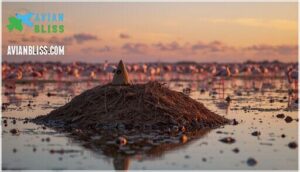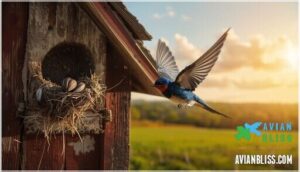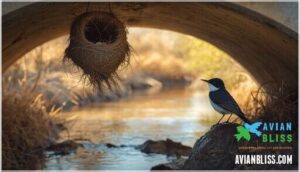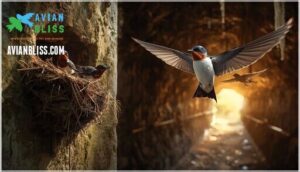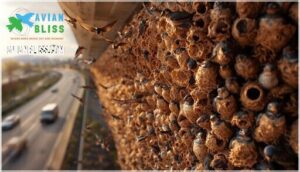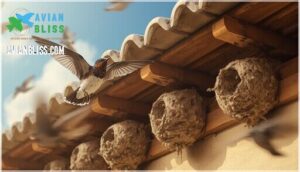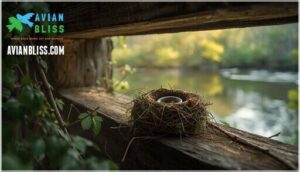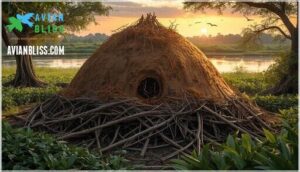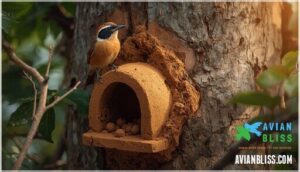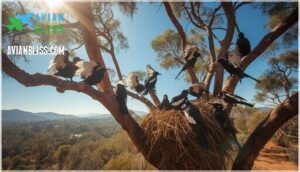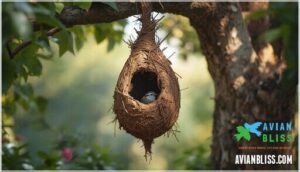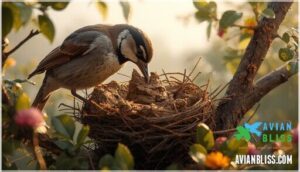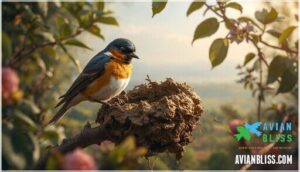This site is supported by our readers. We may earn a commission, at no cost to you, if you purchase through links.
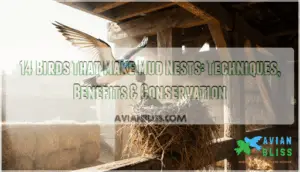 A barn swallow swoops low over a muddy puddle, grabs a beak-full of wet clay, and rockets back to the rafters. Within weeks, that sticky glob becomes a fortress—weatherproof, predator-proof, and engineered with zero blueprints.
A barn swallow swoops low over a muddy puddle, grabs a beak-full of wet clay, and rockets back to the rafters. Within weeks, that sticky glob becomes a fortress—weatherproof, predator-proof, and engineered with zero blueprints.
Fourteen bird species across the globe have mastered this ancient craft, turning dirt and spit into survival tools that outlast storms and shield vulnerable chicks. These aren’t just nests. They’re architectural marvels that reveal how evolution turns simple materials into life-saving shelters.
From cliff faces to barn beams, birds that make mud nests prove that sometimes the best building material is right under your feet—literally.
Table Of Contents
- Key Takeaways
- Birds That Build Mud Nests
- Characteristics of Mud Nests
- Mud Nest Construction Techniques
- Why Birds Build Mud Nests
- Benefits of Mud Nests in The Ecosystem
- Threats to Mud Nesting Birds
- Conservation Efforts for Mud Nesting Birds
- Tips for Birdwatching Mud Nesting Birds
- Unique Mud Nesting Strategies
- Importance of Mud Nests in Bird Biology
- Frequently Asked Questions (FAQs)
- How many birds build their nests using mud?
- Which birds build their nests using mud?
- What birds make mud nests in Texas?
- What birds build nests from mud pellets?
- Why do birds build mud nests?
- Do cockatoos build mud nests?
- What birds make nests out of mud?
- How do you get rid of birds that build mud nests?
- What bird makes a messy nest?
- What Kentucky birds build mud nests?
- Conclusion
Key Takeaways
- Fourteen bird species worldwide construct mud nests using clay, saliva, and plant fibers—creating weatherproof shelters that regulate temperature, deter predators, and can last multiple seasons through strategic reuse.
- Mud nests deliver measurable survival advantages: they reduce predation risk by 30% through enclosed designs, maintain internal temperatures 3–5°C more stable than ambient air, and save birds up to 40% in construction energy when repaired instead of rebuilt.
- These architectural marvels support broader ecosystem health by reducing pest insects up to 98%, enriching soil nitrogen by 40%, and creating microhabitats that house over 35 additional species including wasps, beetles, and beneficial arthropods.
- Conservation threats—including 50% wetland loss since the 1780s, climate-driven droughts that crack nests by 30–40%, and invasive species causing 30% nest displacement—demand habitat restoration, public education, and citizen science monitoring to protect these specialized builders.
Birds That Build Mud Nests
You’re about to meet 14 fascinating species that share one impressive skill: building with mud.
These birds come from all corners of the globe, each with their own unique twist on construction. From flamingos crafting ground nests to swallows plastering homes under your roof, you’ll discover the remarkable diversity of mud-nesting architects.
American Flamingo
You’ll find the American Flamingo in saline lagoons and coastal wetlands of the Caribbean, building cone-shaped mud nests up to 60 cm high. Both parents construct these raised mounds using mud, stones, and saliva to protect their single egg from flooding. Their vibrant feather coloration comes from carotenoid-rich algae they filter through specialized lamellae in their beaks.
These synchronized mating rituals and communal mud nest construction showcase exceptional avian conservation needs in changing flamingo habitats. The conservation of American Flamingo populations relies on understanding their social bird behaviors and protecting their habitats.
Apostlebird
Down in eastern Australia’s dry woodlands, you’ll spot Apostlebirds working as a tight-knit crew. These gray-plumaged birds live in cooperative groups of 5 to 20 members, building impressive cup-shaped mud nests high in tree forks. Their social behavior sets them apart—everyone pitches in on construction, parenting, and defense. The Apostlebirds’ behavior is characterized by strong cooperative breeding habits.
Key traits of their nesting habits include:
- Nest architecture: Mud walls reach 2.54 cm thick, reinforced with grass and feathers, weighing up to 2.3 kg
- Cooperative breeding: Dominant males, females, and juvenile helpers all share nest-building and chick-rearing duties
- Adaptive resourcefulness: When mud’s scarce, they’ll use emu dung instead
Their Apostlebird diet includes insects, seeds, and small vertebrates gathered during daily woodland foraging.
Barn Swallow
While Apostlebirds work in teams, the Barn Swallow takes a more independent approach to Mud Nest Construction. You’ll recognize this feathered friend by its deep-blue back and rust-colored throat as it swoops low, catching insects mid-flight.
Their Nesting Habits revolve around man-made structures—barns, garages, even your porch. Watch them gather 750 to 1,450 mud pellets, mixing in grass and feathers to craft cup-shaped nests.
Bird Migration patterns bring them back to the same nesting site year after year, and they’re smart about it—most reuse old Mud Nests instead of starting fresh. Their Bird Nesting Behaviors show exceptional precision, and these Nesting Materials bond together in days.
Black-billed Magpie
Where Barn Swallows favor quick cup nests, the Black-billed Magpie goes all-in on fortress construction. You’ll spot these bold black-and-white birds building domed stick structures—about 76 cm tall and 51 cm wide—with a hidden mud bowl inside.
Here’s what makes their Nesting Habits exceptional:
- Construction timeline: They start as early as January, sometimes taking three months to finish depending on weather
- Mud Nest Construction: The female shapes the interior mud cup, lining it with grass while both parents gather Nesting Materials
- Smart design: Side entrances offer quick escape routes from predators
- Longevity: These Mud Nests can last four years, and other species often move in after magpies leave
Their Magpie Behavior shows impressive planning. Though non-migratory across western North America, their Foraging Strategies include pest control—grasshoppers and wireworms don’t stand a chance. The Conservation Status reads "secure" in most regions, but climate change threatens their breeding range.
Bird Nesting Behaviors like theirs prove that patience pays off in the wild.
Black Phoebe
Out west, the Black Phoebe proves that location is everything. You’ll find this charcoal-and-white flycatcher plastering mud nests under bridges and building overhangs, usually within ten feet of water.
Females spend one to three weeks crafting cup-shaped structures—mixing mud with grass and lining them with soft plant fibers. Their Nesting Habits include raising one to two broods annually, with incubation lasting roughly 15–18 days.
Feeding Behavior centers on sallying flights to snag insects mid-air. Their Conservation Status reads "Least Concern," with populations actually growing across southwestern habitats.
Cave Swallow
If you’ve spotted a rusty-throated swallow zipping under a bridge, you’ve met the cave swallow. This adaptable mud architect builds open-cup nests from mud and bat guano—yes, guano utilization is their secret ingredient. Both parents share construction duties, choosing vertical walls in caves or culverts for nest site selection.
Their population expansion across Texas has been striking, thanks to culvert nesting under highways. You’ll often find them competing with barn swallows at shared colonies, creating lively interspecific competition hotspots where swallow nesting behavior unfolds in real time.
Cliff Swallow
Under highway overpasses and canyon walls, you’ll find cliff swallows building some of nature’s most impressive apartment complexes. These colonial architects craft gourd-shaped mud nests from 900 to 1,200 tiny pellets mixed with saliva—talk about commitment. Their nest architecture features a narrow entrance that keeps predators guessing.
Watch their swallow nesting behavior during migration, and you’ll see why their nesting site selection favors vertical cliff habitat with protective overhangs. The mud composition creates rock-hard walls through repeated layering, while clever nest camouflage helps colonies of thousands thrive together. Bird nesting habits don’t get more social than this.
Common House Martin
You’ll spot Common House Martins crafting enclosed mud cups under eaves across Europe and Asia. These aerial insectivores gather roughly 1,000 mud pellets—mixed with saliva as natural cement—to build their nest architecture in 7 to 10 days. Both parents share construction duties, often reusing old nests year after year.
Their breeding habits produce two broods of four to five eggs from May through August, while their foraging strategies target flies and aphids near water sources where mud nests thrive in colonies up to 30 pairs.
Eastern Phoebe
Eastern Phoebes don’t just build nests—they claim territory on your porch like feathered squatters with refined taste. These scrappy flycatchers mix mud, moss, and grass into sturdy cups, often layering new nests on old ones across breeding seasons. You’ll find their mud nests tucked under bridges, barn beams, and building eaves across Eastern Phoebe habitats from southern Canada to Texas. Their nesting success rates stay solid thanks to smart site selection and reuse strategies.
Key traits of Eastern Phoebe mud nesting birds:
- Females handle nest building alone over 5 to 14 days
- Nests measure 5 inches wide with 2.5-inch inner cups
- Breeding behaviors produce two broods annually from March through summer
- Phoebe migration patterns bring them back to identical sites year after year
Both parents split feeding duties during the 16–20 day nestling period, proving bird nesting teamwork pays off.
Hamerkops
Hamerkops construct some of nature’s most jaw-dropping mud nests—massive domed fortresses up to 2 meters wide that can weigh 100 times their body weight. You’ll find these engineering marvels in Hamerkop Habitat across sub-Saharan Africa and Madagascar, wherever wetlands provide the mud composition they need.
Breeding Habits show both parents working together, weaving 8,000–10,000 sticks with mud into intricate Avian Architecture that takes 3–14 weeks to complete.
Their Conservation Status remains stable, and abandoned Mud Nests support countless other species seeking shelter.
Purple Martin
While Hamerkops craft colossal domed fortresses, Purple Martins break the mold entirely—they’re swallow family rebels who’ve ditched mud for cavities. You’ll spot these glossy steel-blue acrobats (North America’s largest swallows) measuring 19–20 cm with 39–41 cm wingspans, arriving from Brazil each spring after 8,000+ km journeys. Their Nesting Habits center on artificial housing—gourds and apartment-style boxes—using twigs and leaves, not Mud Nests. Breeding Colonies thrive near water, with Washington State hosting 600 pairs in social clusters exceeding 100 nests.
Here are 3 striking Purple Martin traits:
- Migration Patterns show 60%+ annual return rates to previous Nesting Materials and Techniques sites.
- Feeding Behavior involves catching insects mid-flight with impressive aerial precision.
- Conservation Status reflects concern—Minnesota saw 5.7% annual declines (2005–2015), though Bird Conservation efforts like Vancouver’s gourd expansion (16 to 40 units) stabilize western populations.
Both parents raise 3–6 chicks per season in monogamous pairs.
Rufous Hornero
Unlike Purple Martins, who favor cavities, South America’s Rufous Hornero takes Mud Nest Construction Techniques to architectural extremes. You’ll recognize these robin-sized engineers by their domed, oven-shaped masterpieces—hence their nickname "ovenbird."
Both parents haul roughly 1,500 clay pellets each, mixing mud with dung and plant fibers to create 4-cm-thick walls. Nest Architecture features a curved entrance (curiously, 12% more open rightward), sheltering 3–4 eggs inside.
Their Breeding Habits run August through December across Argentina, Brazil, and Uruguay, where Conservation Status remains stable thanks to urban adaptability—they’ll build on telephone poles as readily as trees.
Spotted Morning Thrush
From Latin America’s oven-domed builders, we cross to eastern Africa, where Spotted Morning Thrushes quietly perfect their own Mud Nests. You’ll find these small insectivores—just 17 centimeters long—across Kenya, Tanzania, and Uganda’s shrublands.
Their Nest Building blends mud with grass and rootlets, creating sturdy cup-shaped homes in low tree branches. Both partners work 3–6 days gathering materials, reinforcing walls against rain.
Thrush Behavior includes ground foraging for beetles and caterpillars, while their synchronized duets defend territories.
With stable populations, Avian Conservation efforts focus on preserving their woodland undergrowth habitats across tropical Africa.
White-Winged Chough
Australia’s White-Winged Chough breaks the mold—this crow-sized bird doesn’t just build solo. You’ll spot groups of 7–10 crafting bowl-shaped Mud Nests together, 5–15 meters up in eucalyptus branches. Their Mud Composition mixes clay with grass, sometimes even manure when rain’s scarce. What’s wild? The whole clan shares Nest Building duties, and larger Social Structures mean better chick survival. Their Chough Behavior includes kidnapping neighbor fledglings to boost group strength—talk about unconventional Breeding Habits.
- Red eyes intensify during excitement—juveniles start with brown, adults flash crimson
- Nest Architecture takes months when droughts limit mud availability
- Communal breeding involves helpers feeding dominant pair’s offspring
- White wing patches flash dramatically against black plumage during flight
Characteristics of Mud Nests
Mud nests aren’t just slapped-together shelters—they’re engineered masterpieces with serious survival advantages. These structures vary wildly in composition, design, and durability depending on the species that builds them.
Let’s break down what makes these nests so exceptional and why they’ve stood the test of evolutionary time.
Mud Composition and Structure
Think of mud nests as nature’s concrete—and the recipe matters. You’ll find these structures depend on a precise mix of clay minerals, saliva binders, and nest building materials that create surprising structural integrity.
- Clay Minerals: Smectite and illite provide plasticity, with mud composition ranging from 15–30% clay mixed with quartz and feldspar.
- Saliva Binders: Mucin-rich proteins act as natural cement, creating a viscoelastic paste that hardens into a load-bearing structure.
- Mud Texture: Barn Swallows prefer fine particles (around 22 µm), while Cliff Swallows use coarser grains (62 µm) for different nest architecture.
- Structural Integrity: The dried composite can bear tensile loads exceeding 50 kPa—strong enough to support eggs and adults on vertical surfaces.
Insulation and Temperature Regulation
Mud nests provide thermal insulation that’s surprisingly effective—keeping eggs and chicks safe from wild temperature swings. Well-compacted mud reduces heat loss by up to 40% compared to grass nests, while walls thicker than 1.5 cm hold internal temperatures 3–5°C warmer than outside air at night.
Mud composition matters: the right mix delays temperature changes by 1–2 hours, giving parents breathing room during cold snaps. Dome-shaped designs retain heat 20% better than open cups, and mud nesting birds like Barn Swallows maintain egg temps around 36–38°C—about 4°C above ambient—through smart nest construction and climate adaptation strategies.
Nest Location and Colonies
Where you set up camp can make or break a mud nest colony. Cliff Swallows concentrate along tidal-fresh river stretches—low salinity means abundant insects and bigger, denser colonies. Only 10% of surveyed bridges actually support these colonial nesters, so habitat selection is picky business. Barn Swallows favor human structures, with 93 nests crammed onto three adjacent buildings in one study. Colony expansion happens fast: Virginia’s Cliff Swallow population grew sevenfold in just 22 years, proving nest placement drives success.
Nesting sites depend on:
- Colony Dynamics: Medium colonies attract diverse breeders; large ones (500+ nests) are rare but powerful.
- Nesting Patterns: Barn Swallows prefer southern-facing walls (37% of nests), optimizing warmth and light.
- Environmental access: Proximity to water and foraging grounds boosts nest success across species.
- Social structure: Cooperative birds like Apostlebirds share mud nests, while Black-Billed Magpies cluster in riparian zones at 2.3 nests per hectare.
Reuse and Longevity of Mud Nests
Ever wonder why some nests seem eternal? Cliff Swallows and Barn Swallows lead the pack in nest reuse patterns, with older birds returning to prime sites season after season. Mud durability peaks under sheltered eaves—nests there last twice as long as those on cliffs.
Nest repair is standard practice: you’ll see birds patching walls and adding fresh feather linings before laying eggs. Reuse benefits are huge—birds save energy equal to hauling 20 to 40 times their body weight in wet soil.
Longevity factors like rainfall and freeze-thaw cycles determine which mud nests survive winter. Smart mud nesting birds know that fixing beats building from scratch every time.
Mud Nest Construction Techniques
Building a mud nest isn’t just slapping dirt together and hoping for the best. These feathered architects follow precise techniques that turn raw materials into weatherproof homes.
Let’s break down how they pull off this impressive construction feat.
Material Procurement and Preparation
You’ve got to admire how birds turn dirt into architecture. When mud sourcing begins, barn swallows collect small wet pellets from puddles using their bills, while cliff swallows make dozens of trips hauling beakfuls of clay.
Here’s where material mixing gets clever:
- Saliva acts as the secret adhesive, creating mud viscoelasticity
- Grass stems and horsehair provide nest reinforcement
- Sand-free silt produces the sturdiest mud construction
- Fibrous additions boost tensile strength by 40%
This nesting material selection determines whether their mud nests survive storms or crumble.
Nest Building Process
Watch how these feathered masons transform mud into fortresses. Once you’ve gathered your clay pellets, the real artistry begins with methodical layering techniques.
Barn Swallows and Cliff Swallows construct their homes through sequential stages that demand patience and precision. They apply each mud pellet individually, pausing between layers to let moisture evaporate. This drying phase prevents collapse—humidity levels around 40–60% work best, and full curing takes 2–3 rain-free days.
Here’s what the construction timeline looks like:
| Building Stage | Duration | Key Activity |
|---|---|---|
| Site preparation | 1–2 days | Clearing and leveling substrate |
| Mud collection phase | 3–7 days | Gathering 1,400+ pellets per nest |
| Layering and shaping | 1–2 weeks | Sequential application with drying pauses |
| Interior finishing | 2–3 days | Adding feather lining and smoothing surfaces |
| Final curing | 1–2 days | Complete stabilization before egg laying |
The nest-building process involves exceptional bird cooperation. Both sexes work together, with walls measuring 1.5–2 cm thick—thick enough for stability without wasting energy. Cliff Swallows shape gourd-like structures with entrance tunnels, while Barn Swallows prefer open cups. Material selection matters: high-plasticity clays mixed with organic fibers create flexibility under stress.
In wet climates, nest construction techniques adapt. Birds might take up to 21 days completing their mud nest construction when drying time’s limited. Sheltered locations boost durability by 35% during storms.
Parental Participation and Cooperation
Both parents share the heavy lifting regarding nest building. In mud-nesting species like barn swallows and cliff swallows, you’ll see mates working side-by-side—one collecting mud while the other applies it. This cooperative breeding isn’t just practical; it’s essential for survival.
- Parental roles balance the workload: About 75% of bird species demonstrate biparental care, with both sexes contributing equally to construction and chick-rearing.
- Social learning shapes nesting strategies: Apostlebirds and white-winged choughs form cooperative groups where helpers from previous broods pitch in, boosting chick survival.
- Bird cooperation adjusts to conditions: Food availability and predation pressures influence how much each parent invests—harsh environments demand teamwork.
This avian behavior reflects evolutionary wisdom. Monogamous pairs dominate mud-nesting species because shared investment pays off. The coordination between mates during nest building reduces individual energy costs while increasing reproductive success.
Nest Architecture and Design
Teamwork lays the foundation, but nest architecture reveals each species’ genius. Nest geometry isn’t random; cup-shaped designs balance structural integrity with minimal material use, while dome-shaped builds enhance water resistance. Mud composition is equally critical—barn swallows, for instance, mix clay with grass fibers and saliva, creating biomechanics robust enough to support their chicks. Aerodynamic design also plays a pivotal role; Rufous Horneros strategically orient their nest entrances away from prevailing winds. These mud nests are more than shelters—they are evolutionary masterpieces.
Mud nesting birds demonstrate remarkable precision in their craftsmanship. Cliff swallows construct gourd-shaped homes with narrow openings, a design that significantly reduces predation risk. Black-billed Magpies, on the other hand, build domed fortresses that provide comprehensive protection.
| Species | Nest Shape | Key Design Feature |
|---|---|---|
| Cliff Swallow | Gourd-shaped | Narrow entrance reduces predators |
| Black-billed Magpie | Dome | Covered roof for protection |
| Barn Swallow | Cup | Open top, ledge-mounted |
| Rufous Hornero | Oven-shaped | Wind-oriented entrance |
Why Birds Build Mud Nests
You might wonder why so many birds go through the trouble of building with mud. It’s not just about having a place to lay eggs—these nests solve real survival problems.
Let’s look at the key reasons birds choose mud as their go-to building material.
Predator Protection and Safety
Survival in the wild takes more than just luck—it demands strategy. Your mud-nesting birds are masters of predator protection, using clever defense mechanisms that turn simple clay into fortress-like shelters. Here’s how they keep threats at bay:
- Nest Camouflage: Birds blend mud with local soil pigments, cutting visual detection by nearly 50%.
- Strategic Placement: Building 3-7 meters high under eaves slashes ground predator access dramatically.
- Colony Defense: Cliff Swallows in groups see 70% fewer losses than solitary nesters.
- Safety Features: Narrow entrances and dome designs physically block larger predators from reaching eggs.
Environmental Adaptations
Beyond protecting their homes from predators, you’ll find these birds are environmental geniuses. Mud nests deliver outstanding climate resilience through thermal regulation—keeping interiors 3°C cooler than ambient air. Cliff Swallows maintain stable nest microclimates at 55-65% humidity, protecting eggs from heat stress.
Mud durability and weather resistance? Apostlebirds build 2.54 cm-thick walls that withstand 45 km/h winds. Rufous Horneros adapt by selecting clay-rich mud in drier regions, boosting cohesion by 70%. These mud-nesting birds master species adaptation through strategic material choices and architectural flexibility.
Energy Efficiency and Cost-Effectiveness
Building with mud isn’t just clever—it’s economical. Cliff Swallows make roughly 1,400 trips collecting mud pellets, expending about 122 kJ per nest. But here’s the payoff: nest material optimization through mud composition mixed with saliva boosts cohesion, slashing construction costs.
Thermal insulation from mud walls cuts energy expenditure during incubation by stabilizing temperatures.
Smart mud nesting birds even reuse nests—60-70% of House Martins repair old homes instead of starting fresh. It’s nature’s version of recycling, proving that efficient nest building pays off season after season.
Evolutionary Advantages
Evolution isn’t just theory—it’s written in mud. Mud nests grant real survival advantages: predator avoidance through enclosed designs with narrow openings drops chick mortality by 30%. Thermal regulation keeps internal temperatures 5–8°C more stable than outside air, protecting vulnerable eggs. Nest stability from saliva-mud composites resists shear stress, weathering storms season after season.
These adaptive traits enable mud-nesting birds to colonize cliffs, bridges, and urban structures—expanding breeding ranges while boosting reproductive success. Bird adaptation through mud composition showcases evolutionary biology in action, proving smart architecture equals genetic fitness.
Benefits of Mud Nests in The Ecosystem
Mud nests aren’t just architectural marvels—they’re tiny powerhouses that keep ecosystems humming along. These structures create ripple effects that benefit far more than just the birds who build them.
Let’s explore how mud nests support the bigger picture of ecological health.
Habitat Conservation and Preservation
When wetlands vanish, mud-nesting birds lose everything. Over 35% of global wetlands have disappeared since 1970, slashing nesting zones. But habitat restoration flips the script. Restored wetlands boost breeding success by up to 40% for mud-nesters.
Conservation strategies like sediment redistribution and wetland preservation counter sea-level rise, saving over 25% of coastal colonies. You’re part of this. Wildlife conservation and environmental conservation efforts protect these architects and maintain ecosystem balance.
Habitat preservation isn’t just about birds—it’s about keeping nature’s blueprint intact for everyone.
Biodiversity and Species Coexistence
Mud nests don’t just shelter birds—they’re biodiversity magnets. You’ll find up to 35 bird species, six wasp species, and countless arthropods sharing these structures across five continents. That’s Species Interactions in action. Here’s how mud nests drive Ecosystem Resilience:
- Resource partitioning reduces competition – Different species use distinct mud minerals and nest heights, with overlap below 40%.
- Secondary tenants boost Habitat Diversity – Up to 28% of abandoned nests house bees and beetles.
- Invertebrate richness jumps 12–23% in shared nesting zones, strengthening Ecological Balance.
- Cross-species vigilance improves predator defense by 15–20%, protecting entire colonies.
- Microbial and arthropod communities thrive – Over 40 bacterial taxa colonize reused nests, enhancing Wildlife Ecology.
This species coexistence isn’t accidental. It’s Conservation Biology at work, where Bird Species Diversity creates cascading benefits. Regions with active mud-nesters sustain up to twice the species interaction complexity. That’s Biodiversity Conservation you can see—one mud nest at a time.
Ecological Balance and Stability
Think of mud nests as ecosystem engineers—they don’t just house birds, they stabilize entire landscapes. Swallow colonies reduce pest insects by up to 98%, triggering trophic cascades that boost pollination and plant health. That’s Ecosystem Services you can measure.
Nest materials enrich soil nitrogen by 40%, fueling microbial networks critical for Ecological Balance. Abandoned nests create microhabitats for invertebrates and mosses, amplifying Biodiversity Conservation.
This ripple effect fosters Wildlife Preservation and Environmental Sustainability across habitats. Through Bird Social Behavior and nutrient cycling, mud-nesting species maintain Wildlife Ecology that prevents population crashes. Their Ecological Importance? They’re architects of Environmental Preservation, stabilizing food webs one mud pellet at a time.
Threats to Mud Nesting Birds
Mud-nesting birds face real dangers in today’s changing world. From disappearing wetlands to unpredictable storms, these architects of clay struggle against forces beyond their control.
Let’s look at the main threats putting their impressive nests—and survival—at risk.
Habitat Loss and Degradation
You’re watching habitat destruction chip away at the foundation mud-nesting birds depend on. Wetland destruction, deforestation impacts, and urban sprawl are rewriting the landscape, leaving these architects without the raw materials or safe spots they need. Since the 1780s, about 50% of U.S. wetlands have vanished, and habitat fragmentation isolates populations while coastal erosion washes away nesting grounds.
Three major drivers threaten their survival:
- Agricultural expansion converting forests and wetlands into farmland, reducing insect prey by 76%.
- Urban development replacing natural riverbanks with concrete, cutting mud access and nesting structures.
- Pollution contaminating mud sources, weakening nest integrity and triggering nest abandonment rates up to 20%.
This ecosystem disruption doesn’t just hurt birds—it unravels the ecological balance connecting water, soil, and wildlife. Environmental preservation and bird habitat preservation aren’t luxuries; they’re lifelines for species already losing ground fast.
Climate Change and Weather Extremes
Climate change isn’t just warming the planet—it’s rewriting survival rules for mud-nesting birds. Rising temperatures trigger extreme weather that hammers these builders from both sides.
Droughts dry up mud sources, shrinking nest-building periods by 25–35% and cracking finished nests by 30–40%. Then floods sweep in, destroying over 50% of nests in low-lying areas.
Heat waves slash nesting success by 30%, while earlier springs throw off bird migration patterns by two weeks, creating mismatches with insect prey. When food peaks before chicks hatch, survival drops 40%.
You’re seeing climate change impact play out in real time—and mud-nesters are losing ground fast.
Invasive Species and Competition
Invasive birds don’t knock before they move in—they just take over. House Sparrows and European Starlings are notorious for nest invasion, aggressively usurping mud nests from native builders like Barn Swallows, Purple Martins, and Cliff Swallows. About 30% of nest boxes in North America showed species displacement from these invaders in 2018. That’s not friendly competition—it’s habitat competition with teeth.
Northern Flickers lost over 35% of their nests to starling aggression, while Purple Martins watch helplessly as invasives claim their artificial houses first. This bird aggression creates cascading ecological impact, disrupting wildlife habitat and threatening conservation status across entire populations.
- House Sparrows monopolize nest sites, blocking native bird species from breeding successfully
- European Starlings cause complete nest abandonment through aggressive displacement tactics
- Common Mynas predate up to 50% of competitor nests in invaded territories
- Invasive species create ecological imbalance that weakens biodiversity in mud nest colonies
Human Disturbance and Disruption
Invasive species aren’t the only ones causing chaos—humans disrupt mud nests just by showing up. Noise pollution from construction masks bird calls and delays nesting, while recreational disturbance reduces parental feeding by 20–30%. Human impact triggers nest abandonment, with breeding success plummeting by 15% in disturbed areas.
Habitat fragmentation isolates colonies, and light pollution forces birds to nest a month early—before food peaks.
You can protect these species by respecting their wildlife habitat and minimizing disturbance effects during breeding seasons.
Conservation Efforts for Mud Nesting Birds
You can’t save mud-nesting birds without getting your hands dirty. Conservation work happens on multiple fronts—from protecting wetlands to rallying communities around shared goals.
Here’s how people are making a real difference for these exceptional builders.
Wetland Conservation and Restoration
Wetlands are the lifeblood of mud-nesting bird habitat. When you protect these essential ecosystems, you’re safeguarding species like Cliff Swallows and Purple Martins that depend on muddy shorelines for construction materials.
Restoration methods include managing water levels, removing invasive plants, and rebuilding natural hydrology—actions that directly support biodiversity management and ecological balance.
Since wetlands provide ecosystem services worth trillions annually and support 40% of Earth’s species, conservation policy must prioritize these areas. Your involvement in wildlife conservation strengthens wetland ecology for generations of mud nest builders.
Public Education and Awareness
You can spark real change for mud nesting birds through community outreach and education programs. When your local school joins initiatives like Maryland’s WILD at Schools or Mass Audubon’s bird conservation units, students learn firsthand about bird nesting behavior and why these mud architects matter. Here’s how you boost conservation awareness:
- Share your bird watching and observation experiences with neighbors to build environmental literacy
- Support citizen science projects that track mud nesting birds and their conservation status
- Advocate for recognition programs like Bird City Maryland that celebrate public engagement
- Connect classrooms with hands-on nest box monitoring through programs like AltaCal’s initiative
Your voice amplifies conservation efforts when you educate others about these extraordinary builders.
Research and Monitoring
Tracking mud-nesting birds requires precision, and researchers are stepping up with powerful tools. GPS telemetry and nest surveillance methods reveal breeding patterns that would otherwise be missed with field surveys alone. Wildlife biology teams now combine visual monitoring with acoustic sensors to track bird nesting behavior across seasons. Data integration from citizen science programs like NestWatch has documented over 58,000 nests, fueling ornithological studies on habitat analysis and conservation methods.
Here’s what modern research captures:
| Monitoring Approach | Key Advantage | Conservation Impact |
|---|---|---|
| GPS Bird Tracking | Real-time nest location | Detects hidden colonies |
| Visual Surveys | Cost-effective data | Tracks mud nest reuse |
| Acoustic Sensors | Measures noise stress | Protects breeding sites |
These habitat analysis techniques inform policies that protect mud nests where they’re most vulnerable.
Community Involvement and Support
You don’t need a PhD to protect mud nests—just a willingness to look up. Volunteer engagement programs like NestWatch connect over 20,000 citizen science participants annually, turning birdwatchers into conservation allies.
Community outreach initiatives through the Bird City Network span 200 towns, proving that conservation partnerships work when neighbors unite.
Public awareness grows as you report nesting behavior, join habitat projects, or attend workshops. These grassroots efforts strengthen wildlife management for vulnerable bird species and improve bird conservation status across regions.
Tips for Birdwatching Mud Nesting Birds
Watching mud-nesting birds is like getting front-row seats to nature’s master builders at work. You’ll want to know where to look, what behaviors to watch for, and how to observe without getting in their way.
Here’s how to make the most of your birdwatching adventures while keeping these feathered architects safe.
Identifying Nesting Sites and Colonies
You’ll find the best nesting sites near bridges, culverts, and barn eaves—places where vertical surfaces meet shelter. Cliff Swallows pack colonies tight, sometimes 200 to 1,000 nests clustered under a single overpass. Barn Swallows prefer human structures like stables, building about 5 to 50 nests per colony.
Check within half a kilometer of freshwater and wet mud—colonial nesters need both for survival. Look for south-facing walls where bird species and habitats overlap with mud availability and nesting materials.
Observing Nesting Behavior and Activity
When you’re watching mud nesting birds in action, you’re witnessing architectural genius on fast-forward. Barn Swallows make around 1,200 trips, each time depositing a single mud pellet with laser focus. Both parents share nest construction duties equally, alternating between mud collection and feeding.
Cliff Swallows work in massive colonies—sometimes up to 3,000 birds—constantly patching walls after rainfall softens their gourd-shaped homes. Notice how breeding seasons align perfectly with rain, when wet mud becomes available.
Watch for these fascinating behaviors during nesting cycles:
- Parents reinforcing nest walls throughout the season to prevent erosion
- Fledgling care rituals where adults alternate between construction and feeding duties
- Cooperative groups like Apostlebirds where multiple birds assist in nest building and maintenance
Minimizing Disturbance and Disruption
You won’t believe how fragile nesting season really is—just one wrong move can tank an entire colony. Studies show frequent human approach within 10 feet slashes reproductive success by up to 40%.
That’s why noise reduction matters. Keep visits under 10 minutes and limit them to once every 3-4 days for nest protection. Move slowly, avoid direct eye contact, and turn off machinery within 50 meters of active mud nests.
Continuous noise above 65 decibels cuts incubation activity by 30%, directly threatening bird safety. Your restraint during this critical period makes all the difference for mud nesting birds and their delicate nest building materials.
Respecting Bird Habitat and Boundaries
Beyond keeping your distance, you can champion nesting site protection by respecting buffer zone enforcement. Federal wildlife agencies suggest staying at least 50–100 meters from active nests—that’s roughly half a football field. Look for visible markers like flags or ropes that indicate protected areas.
These bird-friendly practices cut human intrusion by 40% in monitored sites. Support habitat preservation by sticking to trails and never touching mud nests, even abandoned ones.
Wildlife observation ethics aren’t just rules—they’re your ticket to witnessing nature’s architects without compromising their conservation status or survival.
Unique Mud Nesting Strategies
Not all mud nests are created equal—some birds break the mold entirely. From ornate architectural feats to unusual partnerships, these species push the boundaries of what mud can become.
Let’s check out four strategies that prove innovation thrives in the bird world.
Elaborate Nest Architecture
Master architects, some mud-nesting birds craft structures that rival human engineering feats. Hamerkops construct massive spherical nests, reaching 1.5 meters wide, reinforcing up to 10,000 sticks with mud for structural resilience. Rufous Horneros shape oven-like domes with circular entrances for thermoregulation and predator protection. Cliff Swallows form gourd-shaped avian nests using over 1,000 mud pellets—each piece demonstrating nesting material science at work.
These nest shape dynamics reveal how mud pellet formation and avian architecture create homes that can withstand seasons while showcasing nature’s blueprint for mud nest construction.
Decorations and Adornments
If elaborate nest architecture is the foundation, then nest ornamentation is the finishing touch—and mud-nesting birds take it seriously. You might spot a magpie’s nest gleaming with shiny glass fragments or a barn swallow’s home adorned with feathers pointing skyward. These aren’t random decorations.
Studies show over 60% of mud-nesting species weave feathers or plant fibers into their exteriors for camouflage and insulation. But here’s the twist: nest aesthetics also function as bird signals. Reflective objects boost mate attraction by 25% in some populations.
Visual displays matter—ornamented nests see higher reuse rates and better reproductive success. The mud texture, combined with decorative elements, transforms simple mud nest construction into intricate communication. Every adornment tells a story about the builder’s quality and fitness.
Cooperative Nesting and Social Behavior
Some mud-nesting birds don’t build alone—they team up. Cliff Swallows form colonies with over 3,700 nests, swapping mud runs every few minutes to share the load. Apostlebirds take it further: groups of up to 10 adults raise a single brood together, boosting nest success by 42%. This cooperative breeding isn’t just neighborly—it’s strategic. Larger colonies cut predation by 50% through group defense and shared vigilance. Social learning spreads tricks like synchronized mud gathering, improving nesting synchrony and efficiency. Colonial nesters prove that regarding mud nests, teamwork isn’t optional—it’s survival.
- Colony dynamics create safety in numbers
- Cooperative nesting doubles construction speed
- Nesting behavior improves through social learning
- Bird social behavior strengthens predator defense
Adaptive Nesting Techniques
When temperatures drop, you’ll see birds ramp up their adaptive nesting techniques. Species at higher latitudes build nests with walls 30% thicker than their southern cousins, trapping heat like a down jacket.
Nest material selection shifts with climate—birds in cold, humid zones pack extra plant fibers and feathers into their mud composition.
Even nest architecture changes: Hawaiian amakihi construct deeper, higher nests in cooler elevations to fine-tune thermal regulation. This climate adaptation proves mud nesting birds don’t just survive—they engineer solutions.
Importance of Mud Nests in Bird Biology
Understanding bird nesting habits opens a window into survival itself. Mud nests aren’t just clever construction—they’re lifelines woven into avian architecture and reproductive success. These structures shield vulnerable eggs and chicks from predators while their thermal insulation keeps internal temperatures steady, often 2–5°C cooler than scorching midday peaks. That’s critical when you’re dealing with fragile hatchlings that can’t regulate their own body heat yet.
Here’s where nesting material science gets fascinating: the mud-saliva composite creates tensile strength that allows birds under 100 grams to attach nests to vertical walls or ceilings. Heavier species can’t pull this off—there’s a roughly 400-gram ceiling on mud nest construction due to mechanical limits.
Barn Swallows demonstrate mud conservation biology beautifully by refurbishing old nests, boosting hatch success by 17–23% compared to building from scratch. Colony-based mud nesting birds also cut predation risk by about 28–35%, proving that cooperation pays off in the wild.
Frequently Asked Questions (FAQs)
How many birds build their nests using mud?
You won’t believe it, but only about 57 bird species worldwide truly master the art of mud architecture. That’s less than 6% of all birds on Earth. Swallows like Barn Swallows and Cliff Swallows lead this niche construction crew, shaping up to 1,200 individual mud pellets per nest.
These small architects usually weigh under 100 grams, proving you don’t need size to build something sturdy. Their mud nest construction showcases impressive avian architecture and specialized nesting behavior.
Which birds build their nests using mud?
Swallows are the superstar mud architects. Cliff Swallows craft gourd-shaped masterpieces, while Barn Swallows build cup-shaped nests under eaves.
Cave Swallows, horneros, magpies, and phoebes also mix mud with saliva to create their sturdy homes.
What birds make mud nests in Texas?
Ironically, Texas highways—symbols of human sprawl—became lifelines for mud-nesting birds.
Barn Swallows, Cliff Swallows, Cave Swallows, Black Phoebes, and Eastern Phoebes all craft mud nests across Texas, thriving under bridges and culverts you drive past every day.
What birds build nests from mud pellets?
Cliff Swallows and Barn Swallows construct nests from 900-1,200 individual mud pellets, carefully transported in their beaks.
These master builders craft cup and gourd-shaped homes that offer outstanding insulation and predator protection. Their mud nest construction techniques represent impressive avian engineering.
Why do birds build mud nests?
Here’s the paradox: birds build mud nests despite their fragility, yet these structures outlast countless seasons. Mud nests regulate temperature and humidity, protecting your eggs and chicks from harsh weather and predators. The material’s structural integrity—strengthened by saliva and drying—creates durable sanctuaries.
Your adaptive nesting strategy maximizes energy efficiency; reusing old nests saves up to 40% of construction costs annually. Mud nest architecture evolved to balance protection with accessibility, letting you raise your young safely while minimizing daily foraging demands for building materials.
Do cockatoos build mud nests?
Cockatoos skip mud entirely. These cavity-dwelling parrots excavate tree hollows, relying on wood shavings as bedding.
Unlike mud-nesting birds crafting enclosed structures, cockatoos occupy pre-existing cavities—a fundamentally different avian adaptation strategy showcasing diverse nest construction approaches.
What birds make nests out of mud?
Swallows, phoebes, and magpies craft sturdy mud nests by gathering clay from water sources. These mud-nesting birds layer materials with saliva and plant fibers.
Flamingos, apostlebirds, and horneros also master mud construction for durable, insulated homes.
How do you get rid of birds that build mud nests?
Think of deterrents as building a fortress—you’re making your space inhospitable. Install bird netting under eaves before breeding season for 98% prevention. Add sloped boards at 30–45° angles to eliminate perches. Use reflective tape or predator decoys repositioned every few days.
Pressure wash removed nests at 1,500–2,000 psi, then seal surfaces. Legal compliance matters: swallows are federally protected; hire licensed professionals for active nest removal only.
What bird makes a messy nest?
Several birds make messy nests, but the Black-billed Magpie stands out. It constructs a sprawling dome using mud and twigs over 50 days.
Barn Swallows and European Starlings also create untidy structures due to nest reuse and accumulated waste, particularly in urban areas.
What Kentucky birds build mud nests?
You know the old saying: "Home is where you hang your nest." In Kentucky, you’ll find Barn Swallows crafting cup-shaped mud nests under eaves and bridges, Cliff Swallows building gourd-shaped colonies near waterways, and Eastern Phoebes constructing moss-lined structures around streams and barns.
Conclusion
Here’s the irony: birds that make mud nests wield ancient engineering skills humans spent millennia learning to replicate. These 14 birds that make mud nests don’t need blueprints or permits—they just build, adapt, and survive.
Their mud fortresses prove liberation comes from working with nature, not against it. Next time you spot a barn swallow’s masterpiece clinging to your eaves, remember: freedom isn’t always about breaking boundaries. Sometimes it’s about knowing exactly where to find solid ground.

